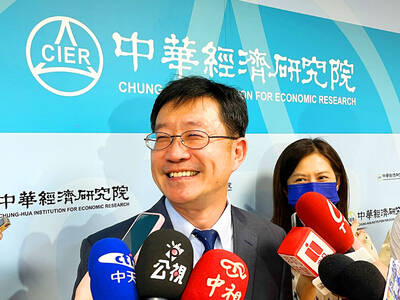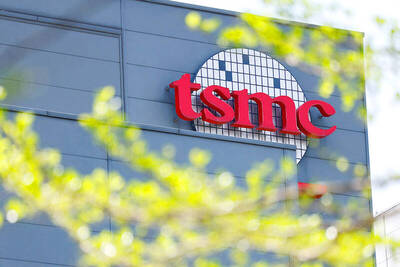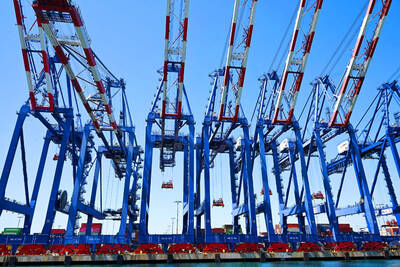Century Iron & Steel Industrial Co (CISI, 世紀鋼構) yesterday inked a memorandum of understanding (MOU) with Orsted A/S to become the preferred supplier of underwater wind turbine foundations to the Danish company, as part of the Taiwanese company’s effort to tap the nation’s renewable energy industry.
CISI’s underwater substructures for wind turbines are to be used in building Orsted’s offshore wind farms off the coast of Changhua County, according to the firms.
“The collaboration with Orsted not only represents CISI’s corporate transformation, but also marks the progress of development in Taiwan’s renewable energy industry,” CISI chairman Lai Wen-hsiang (賴文祥) told reporters on the sidelines after the signing ceremony in Taipei.
The project with Orsted is to be carried out by CISI’s subsidiary Century Wind Power Co Ltd (CWP, 世紀離岸風電), Lai added.
The Danish energy company approached 170 Taiwanese companies over the past year and narrowed its search to 15 local partners for close collaboration, including CISI, Orsted Asia-Pacific general manager and Taiwan branch chairman Matthias Bausenwein said.
“CWP has a strong background in large-scale steel manufacturing and has shown a strong drive to invest in manufacturing offshore wind farms,” Bausenwein said.
Based on the MOU, the Danish company is to share its knowledge in developing offshore wind farms with CWP, helping the Taiwanese firm to build the underwater substructures for Orsted’s wind turbines, the two firms’ said in the joint statement.
CWP is to invest NT$5 billion (US$165.54 million) in purchasing equipment and building two plants at Taipei Port, with the plants scheduled to be in trial operation before the end of 2019 and supplying foundations to Orsted in 2020, Lai said.
In addition to the two plants at Taipei Port, which have a combined size of 16 hectares, CWP plans to rent another 16 hectares of land at the port to store the underwater substructure jackets for the wind turbine foundations, Lai said.
Orsted’s offshore wind farm projects in Taiwan include four sites located 35km to 60km off the Changhua coast. The projects’ total capacity is estimated to be 2.4 gigawatts, supplying electricity to 2.8 million households in the nation.

WEAKER ACTIVITY: The sharpest deterioration was seen in the electronics and optical components sector, with the production index falling 13.2 points to 44.5 Taiwan’s manufacturing sector last month contracted for a second consecutive month, with the purchasing managers’ index (PMI) slipping to 48, reflecting ongoing caution over trade uncertainties, the Chung-Hua Institution for Economic Research (CIER, 中華經濟研究院) said yesterday. The decline reflects growing caution among companies amid uncertainty surrounding US tariffs, semiconductor duties and automotive import levies, and it is also likely linked to fading front-loading activity, CIER president Lien Hsien-ming (連賢明) said. “Some clients have started shifting orders to Southeast Asian countries where tariff regimes are already clear,” Lien told a news conference. Firms across the supply chain are also lowering stock levels to mitigate

Six Taiwanese companies, including contract chipmaker Taiwan Semiconductor Manufacturing Co (TSMC, 台積電), made the 2025 Fortune Global 500 list of the world’s largest firms by revenue. In a report published by New York-based Fortune magazine on Tuesday, Hon Hai Precision Industry Co (鴻海精密), also known as Foxconn Technology Group (富士康科技集團), ranked highest among Taiwanese firms, placing 28th with revenue of US$213.69 billion. Up 60 spots from last year, TSMC rose to No. 126 with US$90.16 billion in revenue, followed by Quanta Computer Inc (廣達) at 348th, Pegatron Corp (和碩) at 461st, CPC Corp, Taiwan (台灣中油) at 494th and Wistron Corp (緯創) at

NEW PRODUCTS: MediaTek plans to roll out new products this quarter, including a flagship mobile phone chip and a GB10 chip that it is codeveloping with Nvidia Corp MediaTek Inc (聯發科) yesterday projected that revenue this quarter would dip by 7 to 13 percent to between NT$130.1 billion and NT$140 billion (US$4.38 billion and US$4.71 billion), compared with NT$150.37 billion last quarter, which it attributed to subdued front-loading demand and unfavorable foreign exchange rates. The Hsinchu-based chip designer said that the forecast factored in the negative effects of an estimated 6 percent appreciation of the New Taiwan dollar against the greenback. “As some demand has been pulled into the first half of the year and resulted in a different quarterly pattern, we expect the third quarter revenue to decline sequentially,”

RESHAPING COMMERCE: Major industrialized economies accepted 15 percent duties on their products, while charges on items from Mexico, Canada and China are even bigger US President Donald Trump has unveiled a slew of new tariffs that boosted the average US rate on goods from across the world, forging ahead with his turbulent effort to reshape international commerce. The baseline rates for many trading partners remain unchanged at 10 percent from the duties Trump imposed in April, easing the worst fears of investors after the president had previously said they could double. Yet his move to raise tariffs on some Canadian goods to 35 percent threatens to inject fresh tensions into an already strained relationship, while nations such as Switzerland and New Zealand also saw increased